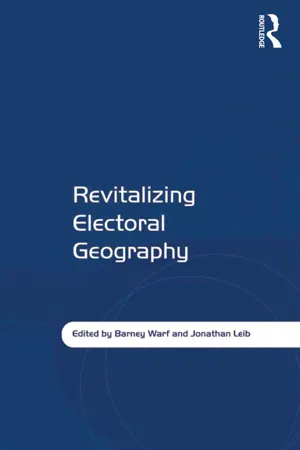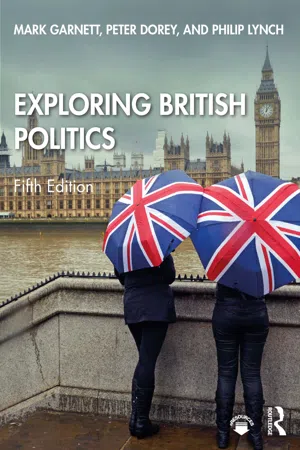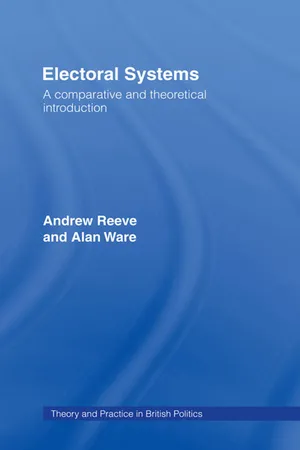Politics & International Relations
Supplementary Vote
The Supplementary Vote is an electoral system used in some elections, where voters have two choices: a first and a second preference. If no candidate receives an absolute majority of first preference votes, all but the top two candidates are eliminated, and the second preference votes of the eliminated candidates are then added to the remaining candidates' totals to determine the winner.
Written by Perlego with AI-assistance
Related key terms
3 Key excerpts on "Supplementary Vote"
- eBook - ePub
- Jonathan Leib, Barney Warf(Authors)
- 2016(Publication Date)
- Routledge(Publisher)
Whereas in FPTP electoral systems voters pick one candidate/party only to receive their support, in preferential systems they place two or more of the candidates in order of preference. The goal is to ensure that the elected candidate has majority support; FPTP in multi-party systems can result in many of the legislators being elected with a minority of the votes only (as was the case with two-thirds of the MPs elected at the 2010 general election). These preferential systems do not eliminate the disproportionality and bias characteristic of FPTP – indeed, they probably accentuate them, because of the issues involved in constituency delimitation – but they also introduce new issues for both parties and electors.The Supplementary Vote
The Supplementary Vote (SV) was introduced in the late 1990s for the election of the Mayor of London and also mayors in a small number of other cities and towns where such a form of government was supported by the local population in a referendum. (It was devised by a Labour MP when his party was considering electoral reform after its third successive defeat by the Conservatives in 1987, was commended by the Plant Commission - Plant, 1993 - and subsequently recommended for the London Mayoral election: Dunleavy and Margetts, 1998; van der Kolk, Rallings and Thrasher, 2004; Rallings, Thrasher and Cowling, 2002.) Voters are presented with a ballot paper in which they indicate both their first and their second preferences. The first preferences are counted, and if one candidate has secured more than 50 percent (i.e., has achieved the quota) he/she is declared elected. If there is no outright winner, there is an instant run-off between the top two candidates. All of the others are eliminated and their second preferences allocated: if they are for one of the first two candidates, they are added to the relevant total; if they are for one of the eliminated candidates, they are discarded, and the second preferences of electors who voted for one of the run-off candidates are ignored. Of the candidates in the run-off, the one with most votes (first plus second preferences) is elected: this may be with a clear majority – if most of the supporters of the eliminated candidates gave their second preferences to one of the candidates in the run-off. - eBook - ePub
- Mark Garnett, Peter Dorey, Philip Lynch(Authors)
- 2020(Publication Date)
- Routledge(Publisher)
Supplementary Vote (SV) . In the AV system, the victorious candidate in a single-member constituency has to achieve an overall majority of votes cast. Electors number all candidates in order of preference. If no candidate secures an absolute majority of first preferences, the lowest placed candidate is eliminated and his or her second preferences are transferred to the remaining candidates. This process continues until one candidate secures an absolute majority.Alternative Vote (AV)an electoral system in which the winning candidate must secure an absolute majority in a single-member constituency. Voters rank their preferences, and votes are redistributed until one candidate secures an absolute majority.Supplementary Vote (SV)The main advantages of AV are as follows:an electoral system in which voters indicate their first and second preferences only. If no candidate wins an absolute majority, all but the top two candidates are eliminated. Second preference votes are added to their tally and the candidate with most votes is elected.- Winning candidates must secure an absolute majority of votes cast.
- The close link between MPs and their constituencies is retained.
- AV is not a proportional system. If used in recent general elections, it would have produced even greater discrepancies between votes won and seats allocated than simple plurality. It is possible for a candidate to win almost 50 per cent of first preference votes but still lose the election.
The SV is a variant of AV. Here the elector records only a first and second preference by putting a cross in the first preference column and another in the second preference column on the ballot paper. If no candidate in the single-member constituency wins more than half of the first preference votes, all but the top two candidates are eliminated. The second preference votes from eliminated candidates are examined and any for the remaining two candidates are redistributed. The candidate with the highest total is then declared elected. SV is used to elect mayors in a number of British towns and cities, including London (see Table 17.3 ), and in November 2014 was the chosen method to elect Police and Crime Commissioners (see Chapter 9 - eBook - ePub
- Andrew Reeve, Alan Ware(Authors)
- 2013(Publication Date)
- Routledge(Publisher)
C would receive only three votes each.The Alternative Vote
This is the other system used in the preliminary example. It aims to produce a majority winner by examining the first preferences of the voters. If a candidate has an overall majority, he or she is elected; if not, the candidate receiving the least number of first preferences is eliminated, and votes cast in his or her favour are transferred to each voter's second-choice candidate. The process is repeated until someone achieves a majority. If it is necessary to eliminate several candidates, a particular voter's third or lower preference might be counted. This system does not take account of the ranking unless a candidate is eliminated, and it then accords the same status to a lower-preference vote as it does to a first-preference vote.Two-stage or ‘run-off’ systems
Urwin identifies a number of different examples of run-off systems; what they have in common is the need for a second round if no-one achieves a majority on the first round (1987b: 30). They differ in the stipulations attached to the qualifications to enter the second round - from the case in which only the top two candidates in the first round are allowed to proceed, guaranteeing (saving the case of a tie) that one will receive a majority of votes cast, to cases in which all previous contestants, and new ones, may enter the second round, which is then decided by a plurality.The single transferable vote
The STV combines some features of the alternative vote, in its elimination procedure, with the special feature of potentially redistributing some votes from candidates who are elected. It relies on defining a quota of votes which someone must receive in order to be elected. John Stuart Mill was a great admirer of what he referred to as 'Hare's scheme' (Mill 1910: 261-7); and Hare was proposing the use of a particular formula for determining the quota. Hare defined the quota as
Learn about this page
Index pages curate the most relevant extracts from our library of academic textbooks. They’ve been created using an in-house natural language model (NLM), each adding context and meaning to key research topics.


